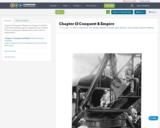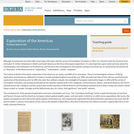
7 Results


In this course the conquest and colonization of the Americas is considered, with special attention to the struggles of native peoples in Guatemala, Canada, Brazil, Panama, and colonial New England. In two segments of the course-one devoted to the Jesuit missionization of the Huron in the 1630s, the other to struggles between the government of Panama and the Kuna between 1900 and 1925-students examine primary documents such as letters, reports, and court records, to draw their own conclusions. Attention focuses on how we know about and represent past eras and other peoples, as well as on the history of struggles between native Americans and Europeans.
- Subject:
- Anthropology
- Arts and Humanities
- Cultural Geography
- Ethnic Studies
- History
- Social Science
- U.S. History
- Material Type:
- Full Course
- Provider:
- MIT
- Provider Set:
- MIT OpenCourseWare
- Author:
- Howe, James
- Date Added:
- 02/01/2004

This collection uses primary sources to explore early exploration of the Americas. Digital Public Library of America Primary Source Sets are designed to help students develop their critical thinking skills and draw diverse material from libraries, archives, and museums across the United States. Each set includes an overview, ten to fifteen primary sources, links to related resources, and a teaching guide. These sets were created and reviewed by the teachers on the DPLA's Education Advisory Committee.
- Subject:
- Ethnic Studies
- History
- Social Science
- U.S. History
- World History
- Material Type:
- Primary Source
- Provider:
- Digital Public Library of America
- Provider Set:
- Primary Source Sets
- Author:
- Kerry Dunne
- Date Added:
- 01/20/2016

This subject examines interactions across the Eurasian continent between Russians, Chinese, Mongolian nomads, and Turkic oasis dwellers during the last millennium and a half. As empires rose and fell, religions, trade, and war flowed back and forth continuously across this vast space. Today, the fall of the Soviet Union and China's reforms have opened up new opportunities for cultural interaction.
- Subject:
- Ancient History
- Arts and Humanities
- History
- Social Science
- World Cultures
- World History
- Material Type:
- Full Course
- Provider:
- MIT
- Provider Set:
- MIT OpenCourseWare
- Author:
- Perdue, Peter
- Date Added:
- 09/01/2003

Interdisciplinary introduction to contemporary Latin America, drawing on films, literature, popular press accounts, and scholarly research. Topics include economic development, ethnic and racial identity, religion, revolution, democracy, transitional justice, and the rule of law. Examples draw on a range of countries in the region, especially Mexico, Chile, and Brazil. Includes a heavy oral participation component, with regular breakout groups, formal class presentations on pressing social issues (such as criminal justice and land tenure), and a structured class debate.
- Subject:
- Anthropology
- Arts and Humanities
- Cultural Geography
- Political Science
- Social Science
- World Cultures
- Material Type:
- Full Course
- Provider:
- MIT
- Provider Set:
- MIT OpenCourseWare
- Author:
- Lawson, Chappell
- Date Added:
- 09/01/2006

This course is designed as an introduction to Latin American politics and society for undergraduates at MIT. No background on the region is required. Overall workload (reading, writing, class participation, and examinations) is similar to that of other HASS-D courses. Many of the themes raised here are covered in greater detail in other courses: 21G.020J (New World Literature), 21G.716 (Introduction to Contemporary Hispanic Literature), 21G.730 (Twentieth and Twentyfirst-Century Spanish American Literaturere), 21G.735 (Advanced Topics in Hispanic Literature and Film), 21A.220 (The Conquest of America), 21H.802 (Modern Latin America), 3.982 (The Ancient Andean World), 3.983 (Ancient Mesoamerican Civilization), 17.507 (Democratization and Democratic Collapse), and 17.554 (Political Economy of Latin America).F
- Subject:
- Arts and Humanities
- Cultural Geography
- Philosophy
- Political Science
- Social Science
- World Cultures
- Material Type:
- Full Course
- Provider:
- MIT
- Provider Set:
- MIT OpenCourseWare
- Author:
- Lawson, Chappell
- Date Added:
- 09/01/2005

The Spanish were savage and barbaric in Mexico… And the Conquest of the Mexica was extremely bloody. But it’s often told as ONLY the Spanish Vs. the Aztecs. And that’s not true… It’s not even close. The so called, “Conquest” of Mexico-Tenochtitlan was really a NATIVE REVOLT. It was ancient indigenous Mexicans against other Native Mexicans. Clearly… the Spanish were the main manipulators.
But it was Native Mexicans who organized, fought and overthrew: Mexico-Tenochtitlan. So much so…. That Native Mexicans accounted for 99% of all people who fought or assisted in the overthrow of the Aztecs, of Mexico-Tenochtitlan in 1521.
And… Who were the Indigenous Mexican allies of the Spanish? They were the Tabascans, the Cempoalans, Texcocans, the Totonacs, Huezotzingos, Chalcas, Quauhquecholtecas, the Zapotec, Mixtec, the Yope, the Xochilmcos, the Tlaxcalans, the Tarascans……And many….. Many….. more. And what did Native Allies provide a handful of Spanish….. Food….. Translation… Advice… Medical Assistance… Labor, especially porters… Housing… Clothing… Guides… Spies.. Messengers….Moral Support…Sex….. And …. Warriors to fight the Aztec and their allies. And much, much, more.
Now… this brief film isn’t a history of the so-called Spanish Conquest….. This is a history of the Native Revolt against Mexico-Tenochtitlan …… it’s a Native Revolution… As Cortes and about 500 Spaniards marched to Mexico-Tenochtitlan from the East… (their maximum number perhaps doubled). He was joined by hundreds of thousands of the largest and fiercest army ever assembled in Mesoamerica.
- Subject:
- Ancient History
- Arts and Humanities
- Ethnic Studies
- History
- Social Science
- World Cultures
- World History
- Material Type:
- Lecture
- Lesson Plan
- Author:
- Professor Estrada Ph.D.
- Date Added:
- 08/09/2023